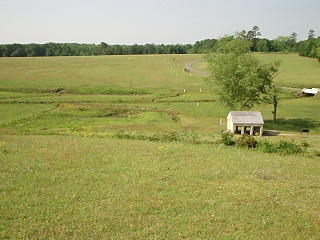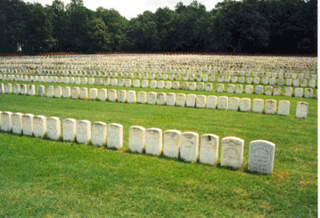OK, with the first trip done, now I needed to work a few bugs out of my system.
For one, I knew I needed a larger pack. Back to the surplus store I went, and got a deal on a Large ALICE pack, without a frame. Because it uses the same frame as the medium pack, this let me save money.
The large pack has roughly 75% more internal capacity, and has 2 larger pockets on the outside, and one huge pocket. It also has 3 smaller pockets, which are the perfect size for eating utensils, toothbrush, and other things. Thus prepared, I moved the pack frame and straps to the new pack, filled it, and set it on the bike.
Another change I made was to put a towel under the pack. During the first trip, the frame rubbed off some of the finish from the plastic behind the seat. With the blanket, it prevents this, and gives me a towel I can use for other things if needed.
Another item I had added in the 2 weeks was a radio. After looking for weeks, I discovered that J.C. Whitney had a tank bag that carried a standard car radio, antenna, and 2 6" speakers. I added an AM/FM/Cassette unit I had inherited from a buddy, and a set of speakers I got from Wall-Mart for $30. It had 3 buckles to attach it, and a quick connect for the power. For less then $110, I now had a radio that I could hear at 70 mph, and could attach or detach it in under 2 minutes! This has been a lifesaver, because it helps to fight the "road fatigue" that can happen after riding for 2+ hours without a break.
This time, I had no set destination. I simply got on the highway, and drove North. My only destination was Columbus Georgia, where the nearest Georgia Visitor Center was located. I already had maps and guides for Florida and Alabama, having them for Georgia would give me more possible destinations for future trips.
Once I got there, I sat on a bench and looked to see where my final destination would be. After 5 minutes, I realized that I was very close to Andersonville!
Now being a history buff, I had done a lot of reading and research. One of the saddest parts of the Civil War was the POW camps. Turner Network Television (TNT) had done a TV movie about Andersonville that I had seen, and had even bought the movie on DVD just a few months before. They crammed roughly 30,000 people into an area little larger then 3 football fields. No buildings, just men living in an open field without shelter. The only water came from a brackish and poluted stream that ran through the middle of the camp.
The camp was surrounded by a 25' wood wall, with a wood rail 6' inside of the wall. This line was the "Dead Line", and any prisoner that crossed it was shot without warning. Having seen the movie and read other accounts, I knew that this had to be my destination.
So off I set, just a destination in mind. I was still 25 miles from the site when it started to get dark, so I started to look for a place to camp. Just as it got dusk, I spotted a small trail leading into a break in the trees. I pulled the bike in, and knew I had found the perfect spot. It was not visible from the road, sheltered by trees, and quiet. 20 minutes later, I had my campsite set up.

One of the best things about camping this way, is that it is free!
If you camp this way, there are some things you should remember however. For one, do not set up a campfire! For one, there is always a danger it may get out of control. For two, you are camping on land that belongs to somebody else. While most rural farmers do not mind campers as long as they are careful, having a fire increases the chances you will be caught, and increases the chances that future campers will not be welcome. ALso, make sure that you do not leave a mess. Pack all of your trash out with you in the morning, and leave it as close to the way you found it as possible.
After a quick breakfast, I was on my way again. I arrived at Andersonville Prison at about 9am, and was awestruck.
I had seen the movie, and if anything it did not do the location justice. Instead of the flat land I saw in the movie, the prison was actually a small valley. There was higher ground on both sides, and the stream ran through the middle in a depression. The stream was brackish and slow moving, and it still stank.

The white posts show where the stockade wall used to stand. The ones to the right were where the wall was. The one to the left was the location of the "Dead Line". The swampy area in the middle was the stream. This was the only source of "fresh" water for 30,000 men. The small building is the location of a spring that opened up when the camp was in operation. Even though it was inside the "Dead Line", the commandant allowed the prisoners to build a wood trough to bring the water to the prisoners.
There are 2 recreations of the original wood stockade on the grounds. Here is one of them, as viewed from inside. In the foreground, you can see a replica of the "Dead Line".

One of the most awe-inspiring sites is the cemetery. Now I have been to veterans cemetaries before. I have seen the rows of tombstones. But this one left me speachless.
The stones in this cemetery are only about 1/4 the size of those in normal cemetaries. And instead of the 2-4 feet between them, these were literally one on top of the other. There are over 12,000 burried there, 460 of them are marked "Unknown".

This should give an idea how closely packed the bodies are. They were simply dumped into trenches and covered. Bodies were literally packed in shoulder to shoulder.

Anybody who knows the story of Andersonville knows the stories of the "Raiders". These were prisoners who preyed upon other prisoners, murdering and stealing. A possee was formed by other prisoners, and they stopped them. The Commandant allowed them to hold a trial, with recent prisoners as jurors. 6 of the Raiders were found guilty of murder, and hanged. These 6 graves are those of the Raiders. At the request of the surviving prisoners, they were burried seperate from the other prisoners.
After a very sobering 3 hours (including a 1 hour guided tour, free of charge by the park service ranger), I bid farewell to Andersonville and headed home.
To anybody that visits Georgia, I strongly recommend a visit to Andersonville. It is a sight that I know I will never forget. I also recommend the movie. It is frequently available from Wall-Mart or K-Mart, normally for $5-10. This is a part of the war that is almost never talked about.
Now that the worst of the summer is past, I am starting to make plans for more trips. My plan for visiting New Orleans this summer is obviously on hold for the unforseen future. My next trip will probably be to a nearby fossil bed I recently discovered. I will provide some pictures of the site, and what I find after I make the trip (hopefully next weekend).







